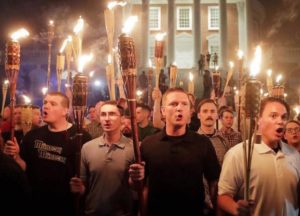Back to Charlottesville: White Supremacy and the Nature of Norms
White supremacists coordinated a “flash mob” tiki torch rally last Saturday night in Charlottesville, Virginia. In addition to chanting they (white people) will not be “replaced,” and “the South will rise again,” and singing the de facto Confederate anthem “Dixie,” the intimate white dudebro gathering featured white supremacist leader Richard Spencer exclaiming whites are being oppressed and erased. After sneakily assembling and “taking a stand” under the cover of night for approximately fifteen minutes, the whites-only pie enthusiasts quickly dispersed like timorous cockroaches exposed to light.
Despite the clandestine nature of this klavern-like demonstration, there has been a marked increase in unapologetic public displays of white supremacist sentiment recently, directly corresponding with the advent of Donald J. Trump and the invidious views he espouses (more on that later).
Many acknowledge this, particularly those with left-leaning political sensibilities. What’s more infrequent, however, is recognition that conspicuousness shouldn’t be mistaken for newness; Trump’s campaign and presidency have merely emboldened these longstanding cultural values.
Racial minorities have always called out, critiqued, and confronted the presence of dehumanizing attitudes, codified into the US social order, that systematically disenfranchise communities of color in ways that restrict access to resources, rights, or opportunities more readily available to whites.
 The widespread bewilderment that racism is very much alive and well in 2017 reveals what I and numerous writers have repeatedly highlighted: far too few understand what racism even entails. Far too few comprehend the overarching impact of navigating a white-oriented nation that cultivates white entitlement. Far too few fully appreciate how Trump’s popularity (despite his profound incompetence) is a direct response to recent political challenges to socialized ideas of white superiority.
The widespread bewilderment that racism is very much alive and well in 2017 reveals what I and numerous writers have repeatedly highlighted: far too few understand what racism even entails. Far too few comprehend the overarching impact of navigating a white-oriented nation that cultivates white entitlement. Far too few fully appreciate how Trump’s popularity (despite his profound incompetence) is a direct response to recent political challenges to socialized ideas of white superiority.
To better explain this ravenous thirst to maintain the inheritance of colonized glory—what Ta-Nehisi Coates refers to as the bloody heirloom—I sought insight from award-winning sociology professor, writer, and author, Anton L. Allahar. When it comes to what culture is and the influence of dominant culture, Allahar says,
Culture is the way of life of a people. Culture comprises both material and ideational dimensions.
The dominant ideas in any culture will reflect the ideas of the most powerful, those who control the means of disseminating those ideas for if there is to be social order the less powerful must come to accept the ideas of the most powerful as the correct and right ideas. This is effected via a process of ideological indoctrination. The principal institutions responsible for the spread of the dominant ideology are the media, the educational system, the religious institutions and ordinary popular cultural fare such as movies, music, jokes and seemingly innocent play.
The dominant culture of the US was formed to give preference to and propagate the white supremacist cis-heteropatriarchy, a sociopolitical system in which cisgender, heterosexual white men hold social dominance at the expense of subordinating racial minorities, transgender individuals, non-heterosexual sexual orientations, and women.
Part and parcel to these interconnected systems of oppression are racist cultural messages that present whites as whole human beings while pathologizing blackness and regarding non-whites as inferior. These ideas become entrenched in our subconscious and infiltrate our social attitudes developed through the socialization process.
A common retort I encounter is, “But this country has changed so much. Quit complaining. Racism isn’t nearly as bad as it used to be!”
Yes, this country once openly accepted and even celebrated racism. With the social and political victories of the Civil Rights era, the cultural imagination of what it means to be a racist began to transform. The US underwent a cultural shift that reimagined racism to be the social equivalent to what a devout evangelical considers the most depraved idea of “sin.” Public acceptability and any association with racism developed into a social taboo.
Sadly, this social realignment was only superficial.
While it’s awesome that folks generally recognize that racism is “bad,” there was and remains a monumental failure to educate the public about the intricate nature of white supremacy intertwined with racism, the significant role it plays in this nation’s socio-historical hierarchical arrangement, and how it functions as a system that thrives even in a more subdued manner.
Racial avoidance and racial ignorance isn’t equivalent to racial consciousness and anti-racist practices. The latter acts to diminish racism, the former ensures it will persist.
To be sure, America’s “racial problem” extends beyond the right-wing political spectrum, as it’s been revealed again and again and again that left-leaning whites and racial ignorance (and thus, complicity with racism) are familiar bedfellows.
 Even so, Trump’s vision for this country—encapsulated in the slogan “Make America Great Again”—offers a return to the “good ol’ days” of flagrant racism. It isn’t at all surprising that Trump successfully courts the fear, resentment, and self-interests of a white reactionary constituency that wants to upend further recession of white-centeredness.
Even so, Trump’s vision for this country—encapsulated in the slogan “Make America Great Again”—offers a return to the “good ol’ days” of flagrant racism. It isn’t at all surprising that Trump successfully courts the fear, resentment, and self-interests of a white reactionary constituency that wants to upend further recession of white-centeredness.
White-centeredness is a deeply-rooted aspect of US culture. White-centeredness denotes the centrality of white representation that permeates every facet of our dominant culture. It upholds as “normal” and “expected” the ubiquity of language, ideas, prejudices, preferences, values, social mores, and worldviews established by the white perspective.
What Trump offers his supporters is the golden ticket to end all golden tickets: an insular quest to prioritize and enshrine the collective interests of white America and to neutralize social changes diverging from white-centeredness.
All this, of course, is white identity politics, but this goes mainly undetected by so many white Americans who are socialized to regard the sustaining of dominant white culture as “what is expected” or “the way things ought to be.”
It is therefore no coincidence that anti-immigration sentiment, the imagined “war on drugs,” racist dog whistle politics, and the mechanisms of mass incarceration that surgically target communities of color are regarded as somehow appropriate and just within the mainstream consciousness.
Allahar addresses the contrary nature of norms that grant a surplus of meaning to whiteness at the expense of those defined as the other:
“While the US extolls the virtues of democracy, equality, freedom and fairness, it is also true that various US governments have been known to install and support dictators in other countries. And as the recent events of Charlottesville show, racism, fascism, Nazism and the KKK are also part of the American social fabric.
After all, the country was built on slavery, racism, Native genocide, colonialism and imperialism, even though most are in denial of these facts. And to the extent that racism, sexism, homophobia and xenophobia are widely practiced, young people are socialized to that ethic. Of course, not all Americans are racists etc., but the current president of the US, the key advisors he has appointed, and the 63 million Americans who voted for him bear eloquent testimony to this claim.”
The fact that Trump was ever able to sniff the Oval Office is a testament to the power of white supremacy.
The power of white supremacy is revealed in recent removals of Confederate monuments generating a spike in Confederate flag sales.
The power of white supremacy is revealed when many within white America construe kneeling during the national anthem as being more depraved and more worthy of contempt than the unjust murder of black and brown lives.
When I look at Trump, I don’t see him as the problem. Rather, in him I see the expected byproduct of white America’s desperation to consolidate the power of the white supremacist cis-heteropatriarchy before another morsel is chipped away by the “assault” of inclusion, multiculturalism, and full liberation of marginalized groups.
Those truly concerned with “stopping” Trump must also commit to dealing with uncomfortable truths that infest the context that brought him to power. Dereliction of this responsibility will guarantee that the legacy Trump exploits will continue to thwart social progress, bastardize justice, and uphold the great moral compromise that asserts white lives hold more value than others.
